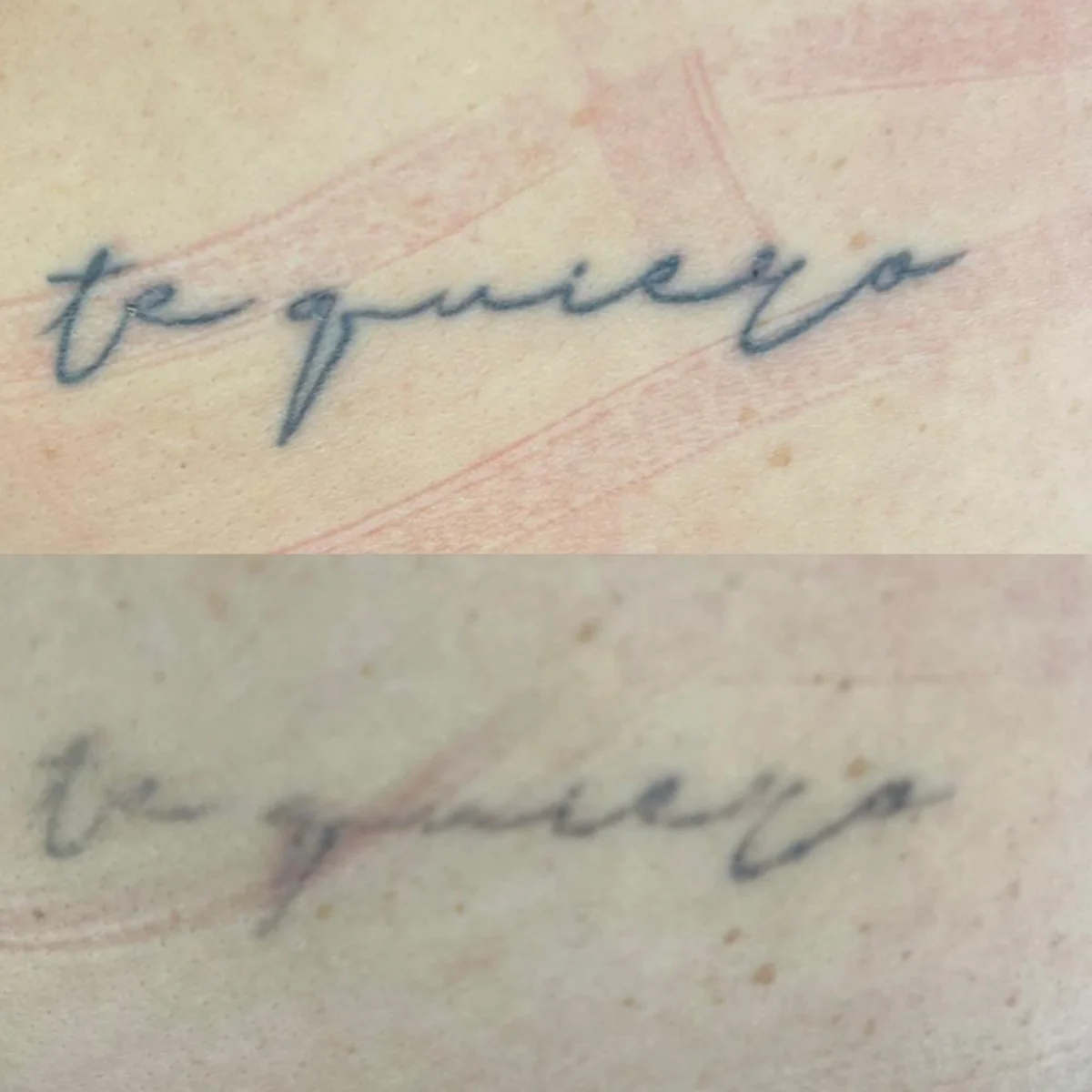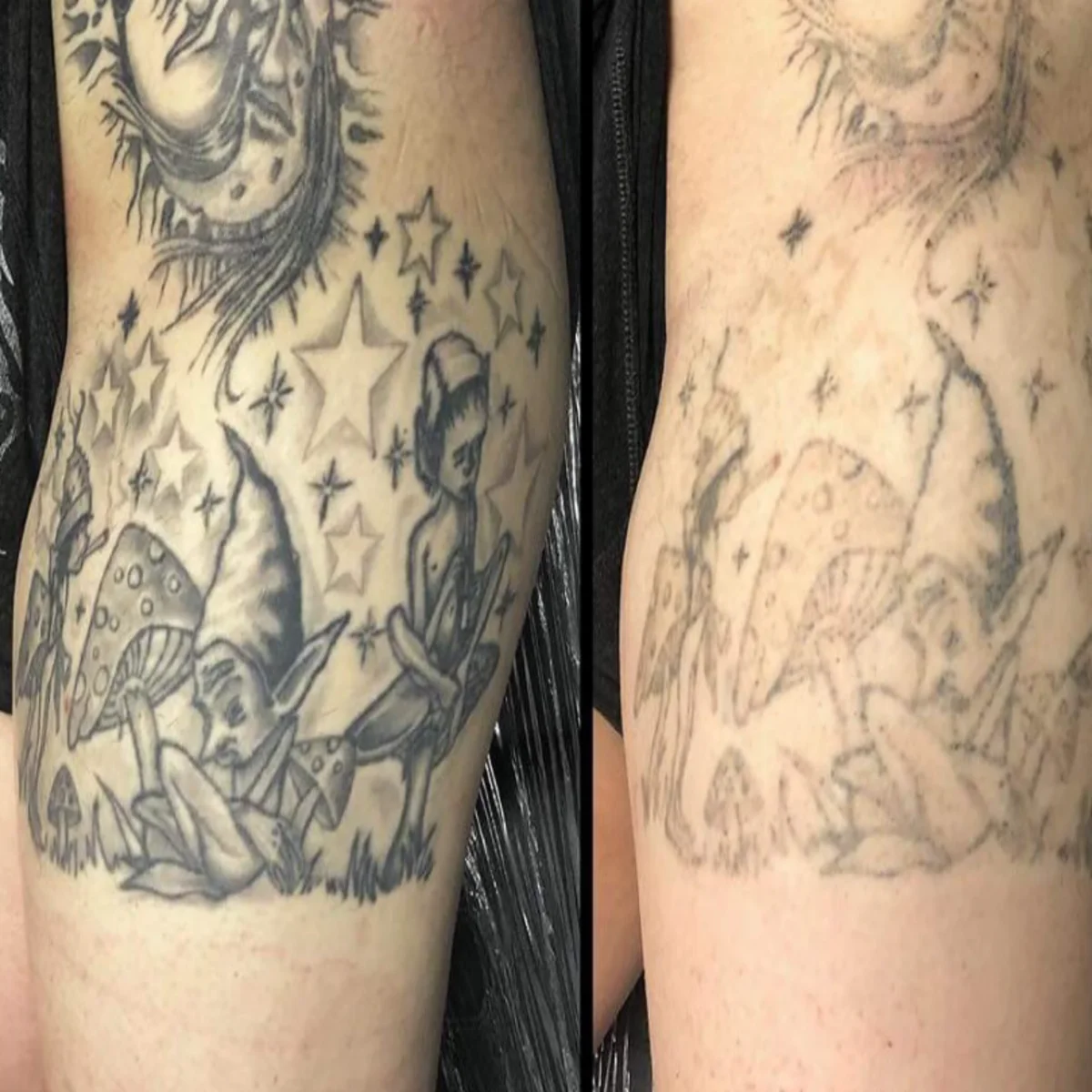The Laser Tattoo Removal Healing Process

The Laser Tattoo Removal Healing Process
Step-by-Step Guide to Healing Post-Tattoo Removal
The actual laser tattoo removal session is a quick, minute-long process. Depending on the size of the tattoo, the procedure usually takes between one to five minutes—about the same time it would take to cover the tattoo with a highlighter.
Although the treatment is swift, recovering from tattoo removal is a more prolonged affair. This healing period follows each removal session.
Understanding the Tattoo Removal Process
To grasp the recovery process, it’s crucial to understand what occurs during a tattoo removal session. The laser gently fractures the ink, allowing it to be naturally expelled from the body.
The Laser’s Mechanism
Sarah explains, “This process leverages your immune system to eliminate the ink safely.” When you receive a tattoo, the ink particles are embedded into small pockets within the dermis layer of your skin. Your immune system has attempted to remove these particles since applying the tattoo. “Upon getting a tattoo, your body actively tries to expel it, as it’s a foreign substance in the skin that doesn’t belong there,” Sarah states. However, the ink particles are around 100 to 200 nanometers in size—too large for your immune system to handle before laser treatment.
The laser targets these ink particles, causing them to shatter into smaller fragments. This enables your immune system to identify and remove them. “Your white blood cells can now engulf these smaller ink fragments, whereas previously, the particles were too large for them to handle,” Sarah elaborates. The white blood cells then transport the ink particles to the body’s lymphatic system, where most are expelled through the digestive system, though some may also be eliminated through sweat or urine.
Ink Breakdown by the Laser
The laser uses a photoacoustic effect that targets the ink with sound energy rather than heat. Its incredibly brief pulses, lasting one trillionth of a second, make the tattoo removal process exceptionally gentle compared to other methods.
Laser’s Impact on Surrounding Tissue
Laser technicians are adept at using specific wavelengths to target only the tattoo ink, ensuring the surrounding tissue remains unharmed. When treated by a skilled technician in a reputable facility, you don’t need to worry about damage to adjacent tissue. The technique employed, selective photothermolysis, ensures that the laser’s energy is attracted solely to the ink particles, not the surrounding tissue.
Healing Breakdown Post-Tattoo Removal by Remover
Here’s what to anticipate during the healing stages of tattoo removal.
Immediate Expectations After Laser Tattoo Removal
Experiencing redness, swelling, slight blistering, mild itching, and raised areas is entirely normal and to be expected post-treatment. Initially, the skin will feel tender and sensitive. These reactions should subside within a maximum of two weeks.
Approximately fifteen minutes after removal, the area will appear red, swollen, and possibly itchy. This condition will persist for about a week. “I always reassure clients when I treat them not to be alarmed by the redness; it’s completely normal,” Sarah remarks. “However, it won’t be painful by the day following the treatment.” Even after the procedure, clients generally feel fine and can continue their daily activities without hindrance.
You might also observe a “frosting” effect immediately after the laser removal, which gives the tattooed skin a chalky appearance. This entirely normal effect indicates the release of carbon dioxide from the skin. This temporary reaction usually lasts a few minutes to half an hour after the laser removal. If it persists longer, contact your removal specialist, though this is highly unlikely.
On the first day of recovery, your body is still reacting to the laser treatment, so the area’s appearance may change, such as increased swelling. Again, these effects are expected, but you should still discuss concerns with your laser technician for peace of mind.
What Occurs During the Initial Week?
Post-laser treatment, the body will persist in eliminating and digesting the ink throughout the first week. This stage marks the beginning of the skin’s healing process, although it may still appear red and swollen for most of the week, which is normal. A significant portion of the ink targeted by the laser during the session is carried away by the body during this time, even though an immediate difference might not be noticeable. The body will continue eliminating some ink in the subsequent weeks (up to about the sixth to eighth week). Still, the quantity will gradually decrease each week until your next laser appointment.
Interval Between Tattoo Removal Sessions for Healing
How long should you wait between tattoo removal sessions? The healing time required varies from person to person, depending on factors such as their immune health. Your technician will decide the optimal spacing between treatments for the best results. Recovery typically recommends a six to eight-week interval between sessions. During this time, your body will digest the ink while the skin heals from the treatment.
Clients sometimes experience skin fatigue, meaning the skin takes longer than six weeks to heal fully. With skin fatigue, the body’s efficiency in removing ink also diminishes. This can occur if the skin isn’t given enough time to recover between sessions or if the laser settings are incorrect. The effectiveness of your immune system significantly influences how well the body can digest and eliminate the ink particles broken down by the laser. Consequently, your overall health can impact the duration of your recovery process.
Factors That Could Prolong Healing
The healing process of laser tattoo removal could be extended if the client picks at blisters or scratches the area, preventing the skin from healing properly. This can also lead to infection or permanent scarring. It’s best to leave the area alone and let the body heal naturally.
Additionally, staying hydrated, exercising regularly, and avoiding smoking can help expedite the removal process, as smoking can impair the immune system.
Reactions to Tattoo Removal
Severe adverse reactions during the healing process of laser tattoo removal are exceedingly rare. If you adhere to your technician’s advice, you’ll unlikely encounter any complications from the removal. Here, we’ll discuss some relatively common reactions that shouldn’t cause panic.
Common Side Effects of Tattoo Removal
The three main types of adverse reactions are redness, swelling, and blisters. Let’s delve into what causes each of these, their appearance, and whether there’s cause for concern.
Redness
Post-treatment, you’ll notice redness, formally known as purpura, in the laser-treated area. This lasts for one to two weeks at most. The redness results from capillaries leaking into the skin, aiding the body’s immune response triggered by the removal session. This should not be alarming, as the increased blood flow aids in flushing out the affected ink.
Swelling
Most clients experience swelling immediately after the removal session and throughout the first week following treatment. This shouldn’t be a matter; however, you can always consult your technician if you have any questions about your body’s response to the treatment. In nearly all cases, the specialist will reassure the client that the swelling is expected.
Blisters
Occasionally, Recovery clients experience blistering during the healing process. Recovery can assist in draining anything more significant than the size of a dime.
Infection is rare, but it’s essential to be aware of the signs, which include a rash, chills, and discharge from the treated area. Inform your removal technician if you experience any of these symptoms.

Frequency of Reactions
While blisters may occasionally occur and swelling is normal, significant adverse reactions are rare. It’s unconvinced that you’ll experience a reaction needing follow-up care. Allergic reactions can happen infrequently and are typically not intense. Sarah has never witnessed a client needing to seek medical attention.
Although side effects of removal are generally not serious, it’s crucial to inform your doctor about any reactions you experience. Technicians are engaged in maintaining close communication with clients throughout the healing process of laser tattoo removal Melbourne.
Preventing Adverse Reactions
To avoid more severe reactions, such as long-term discolouration or scarring during the healing process, choose a reputable facility specialising in laser removal and using state-of-the-art tools.
Then, stick precisely to your specialist’s aftercare instructions for tattoo removal Melbourne. The most crucial aspect is to avoid touching the treated area to prevent unnecessary irritation and to keep it away from sunlight. “Essentially, we’re asking you not to touch it,” Sarah highlights. “Don’t do anything to it. Let your body remove the tattoo.” This approach will help you avoid permanent damage and rev your recovery time.
- Staying out of the sun will also prevent any changes in pigmentation. “You can tan the rest of your body; just cover the treated area,” he advises. Use effective sunscreen or completely shield the area.
- Keep the area clean and dry for the first day. Do not cover or wrap it, and apply a thin layer of hydrocortisone cream once daily for the first five days. You may be able to shower as usual; confirm with your technician first. However, do not submerge the area in water.
- Fully comply with their aftercare guidelines, just as you would follow a doctor’s instructions after a medical procedure, to achieve the best possible outcome.
“Follow your laser specialist’s aftercare guidelines, as they are the experts in tattoo removal,” Sarah advises. Sticking to their instructions will ensure the briefest, safest, and most effective removal process. “These individuals are trained to an incredibly high standard. We are the experts in this specialised industry,” she asserts.